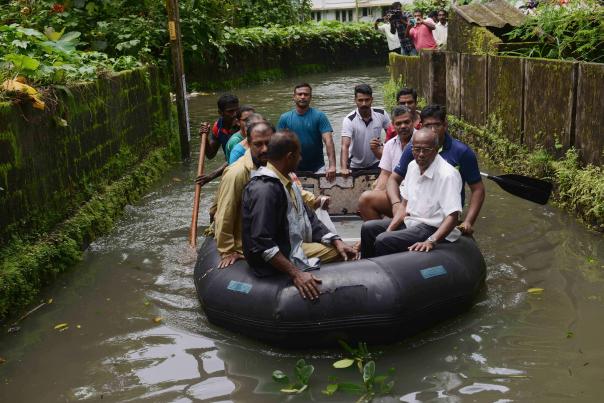Kerala is the latest target to face Nature’s fury. Monsoon had always been a time of rejuvenation for that state. The luxuriant foliage and unique shades of green exclusive to Kerala burst forth best during monsoon. This year, however, monsoon rains have brought upon the Malayalees untold misery and sadness. Known popularly in tourist circles as ‘God’s own country’, the Keralite is an outgoing, affable and industrious individual. Whether as nurses offering medical help across the globe or working hard in the Middle East, the people of this state are never known to beg for anything from anyone else in this country. With a populace considered to have the highest percentage of literacy, the average Keralite has never been perceived as a burden on the Indian government. However, the present flood related disaster showed the soft underbelly of unpreparedness, claiming hundreds of lives in a matter of days. While states such as Orissa and Andhra Pradesh that are often affected by natural calamities are compelled to maintain a better response mechanism, Kerala seems to be completely floundering. Media visuals show how hillsides have collapsed completely and washed away huge buildings. This indicates that prosperity has had a negative impact of neglecting environmental considerations. Some images looked similar to those of Uttarakhand, which had faced terrible floods and resultant landslides owing to rampant clearing of forests for construction and development.
The scale of damage is unprecedented and unforeseen perhaps also because the state never expected such a devastating deluge. Ironically, unused to such calamities, a lot of marooned people are unwilling to be airlifted to higher ground. This makes rescue and rehabilitation efforts even more daunting than it should be. Although relief is pouring in from multiple sources, it is not known how the measures have been streamlined. This reminds us of the Super Cyclone that hit Orissa in 1999. An unprepared machinery could not reach people on time or even distribute food and other essentials that came in not only from the Union government but also from international sources. Corrupt bureaucrats of that time had minted money while people suffered. While sitting far away and having experience of various kinds of natural calamities, we can only surmise on what could go wrong in times of distress.
Although the capital of the state is located right in the middle of all the mayhem, that Thiruvananthapuram itself is having to struggle for a semblance of order is a matter of great concern. Parts of the capital have been facing water logging issues almost each year. So much so that areas close to the railway station get flooded, forcing passengers to face hardship. The issue in Kerala has arisen as a result of multiple factors. Real estate development in that state is happening at an unsustainable rate and at the cost of its green cover, which is vital in managing flood situations. The narrow state which has a sharp incline towards the West sees rivers being obstructed by indiscriminate construction. Although the state may stake claim to sizeable forest cover, its hills are facing rapid deforestation and replacement of natural forests with plantation crops. Pamba, a river of significance and association with the hill shrine Sabarimala, is in spate as are other rivers in the state. Nearly 35 dams across the state, including the large Idukki dam, which opened its gates after 26 years, and the Mullaperiyar expected to open its gates anytime, are all contributing in worsening the situation. The Pamba river is a prime example of how the courses of rivers are being obstructed and what devastation it can cause. What the river has done to the infrastructure that the Travancore Devaswom Board had developed for the benefit of devotees will come to light only when the water recedes to normal levels. The Pamba also faces multiple threats from the commercial interests that have arisen from the tourism potential in the area. Kochi town is another example of rampant urbanization. Many parts of Kochi have come up on delta plains of rivers. These are bound to face flooding. The unprecedented rains this season have only exposed the reality that was being ignored. The only way to protect populations from such disasters is to create awareness about protection of the environment. The state machinery too has to gear up for such unforeseen calamities. These calamities teach important lessons not only to the government but also to the populace at large.
Interestingly, the Prime Minister, who conducted an aerial survey of the flood-affected areas could only promise assistance of Rs 500 crore (which took central assistance to a cumulative Rs760 crore) to Kerala, whereas the same government has allocated thousands of crores each for statues of Shivaji and Vallabhbhai Patel to be put up in Maharashtra and Gujarat respectively. The Union government has also shown hesitation to declare this as a National Calamity for reasons unknown. The only reason that can be attributed to this kind of lackadaisical attitude is political motivation. It is therefore sad to note that in our country, the average citizen is treated by the government solely on political affiliations and patterns of voting, not as a person deserving government’s protection at all times.
Excessive greed generated due to economic prosperity is inevitably leading to destruction of environmental balance. This is extremely pronounced, especially in India. While other affluent societies tend to become caring towards nature and its requirements, we in India consider wealth as a protection against the laws of that same Nature. Whether in Kerala or Uttarakhand, the mindset of Indians seems to be equally disturbed and unconcerned. Before we can sit back and criticise the government for inaction, the need to be conscious, caring and self-reliant seems to be getting even more important.
